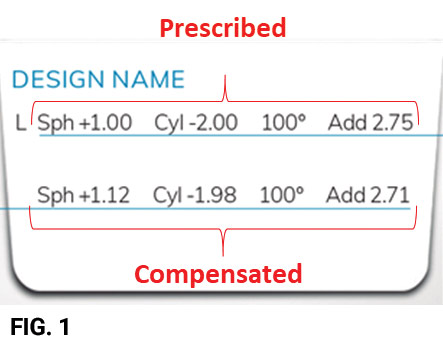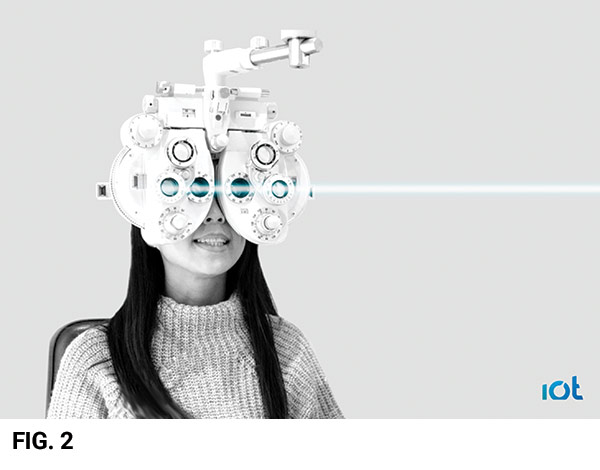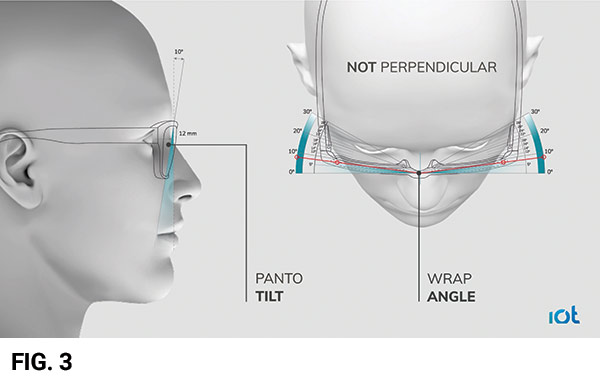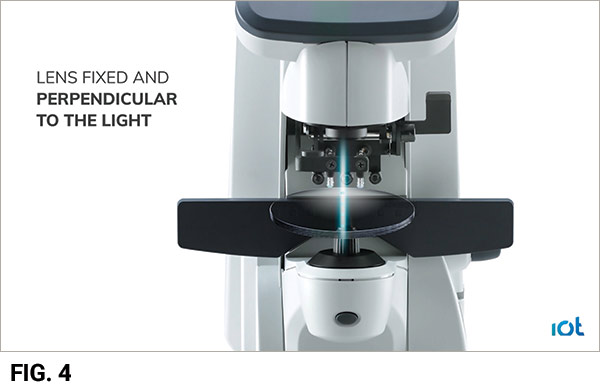Sponsored by IOT
By Tina Lahti, ABOC
When I talk to laboratories, their hot issue is they wish dispensing opticians understood how to verify a personalized (compensated) free-form lens. They tell me repeatedly that opticians often don’t know how personalization (frame fit) parameters (back vertex, panto and wrap angle) impact the power and lens aberrations experienced by the wearer. Everyone must understand with free-form compensated lenses, the lab sends two forms, one with the doctor’s prescribed power listed and the other indicating the compensated verification values. The verification power values are not what the wearer perceives. These values are strictly for verifying the lens in a lensometer.

So why do compensated values given by the lab for verification differ from those prescribed? It’s a flat lens versus an angled lens scenario.
The phoropter lens (Fig. 2) the doctor uses to determine the corrective power sits flat in front of the eye with the lens’ optical center in line with the patient’s visual axis.

Does the frame as-worn sit flat in front of the patient’s eye? (Fig. 3) The answer is no. Therefore, will the perceived power in a tilted lens equal the prescribed power? Again, the answer is no. Changing the angle or back vertex distance changes the power perceived. In this case, the wearer is not getting the doctor’s intended correction if the lens is not compensated. Put another way, the compensated lens delivers the same power to the wearer in a lens with tilt and wrap as the flat lens produced in the phoropter.

Now it’s time to verify. Why do the compensation values differ? Because these values represent the power, the lensometer (Fig. 4) reads from the flat lens. If you could create the exact as-worn tilt angle with the lens in the lensometer, as exists in front of the patient’s eye, you would read the prescribed power. However, since this is highly unlikely, the lab tells you what the power will read when verifying it in the lensometer.

I have been asked why the compensated verification form values have a cylinder value when the prescription doesn’t. An unwanted cylinder is one of the errors induced by tilt and wrap angle as-worn. So the reason your verification form had a cylinder listed when the prescribed power didn’t is the unwanted cylinder introduced by tilt has been compensated. The verification values show you the errors compensated.
You hear many free-form terms and no doubt find them confusing, so the following are common terms defined:
Personalized: A personalized free-form lens describes a lens optimized to produce the best vision based on an individual’s prescription and fitting parameters. When the patient-specific position-of-wear measurements are provided, personalized lenses are often referred to as customized.
Optimization: The free-form lens surface is modified point by point to produce the best optics for the prescription, base curve, refractive index, biometrics (mono-PD), gaze angles, position-of-wear frame/fit parameters, and frame shape and size.
Compensated: Free-form lenses are optimized to compensate or offset the difference between the prescribed and the as-worn perceived power seen through the lens. Compensation alters the free-form lens surface to provide the prescribed power in a lens whose optical center is viewed at an angle to the person’s optical axis. Free-form compensation can also include the back vertex distance when different from the refracted BVD.
Position of wear or as-worn parameters: The free-form values used in a personalized lens when compensating the pantoscopic tilt angle, the frame wrap angle and back vertex distance (BVD).
Prescribed power: Prescribed power equals the power produced by placing a flat lens in a phoropter at a specific vertex distance from the corneal apex of the patient’s eye. The flat lens in the phoropter used by the doctor to measure the refractive error sits perpendicular to the patient’s visual axis, and the lens’ optical center and patient’s visual axis align.
Hopefully, we’ve cleared up this point of confusion. The as-worn compensated Rx numbers are NOT changing the doctor’s prescription! Instead, a compensated lens is modified so that the power produced equals the prescribed power for the wearer based on frame fit.













